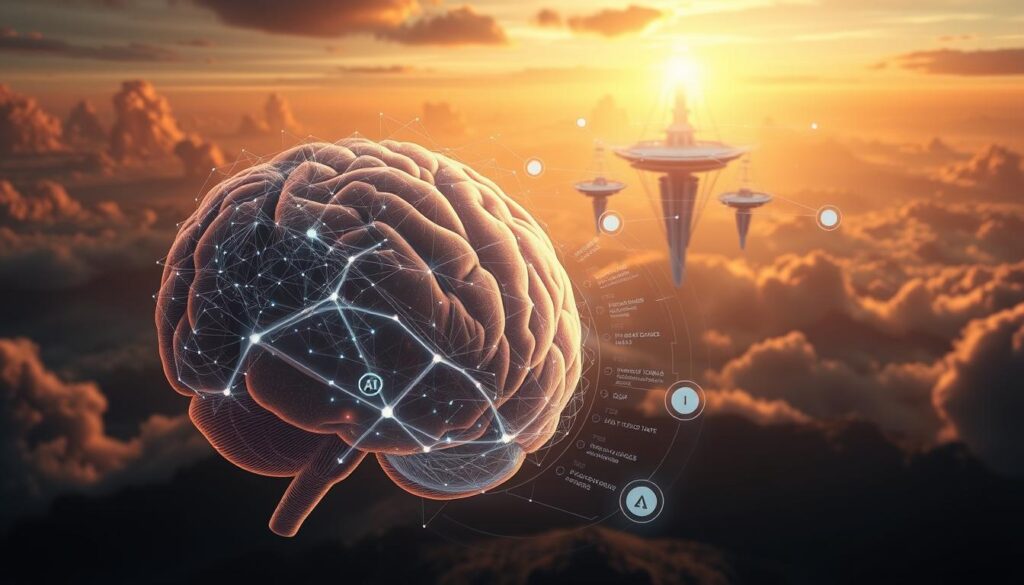The debate surrounding AI tools has intensified as these technologies take center stage in our daily lives. Designed to enhance productivity and streamline learning, these tools raise pertinent questions about their actual impact on our intelligence and motivation. Are we becoming smarter or just increasingly reliant on digital solutions? As we delve deeper into the nuances of AI tools, we will explore their transformative effects while considering the risks of over-dependence and the potential for laziness that may accompany their use.
Key Takeaways
- AI tools can enhance productivity by automating tasks.
- Technology’s role in learning continues to evolve.
- Concerns exist about digital dependency promoted by AI solutions.
- AI may unintentionally encourage a lack of critical thinking.
- Finding a balance is essential for maximizing benefits.
The Rise of AI Tools in Everyday Life
The rise of AI tools has transformed numerous aspects of our daily lives. From virtual assistants like Siri and Alexa, which help manage our schedules, to AI-driven recommendation systems on Netflix and Spotify that curate personalized content, artificial intelligence in daily life enhances our convenience and enjoyment.
Reports from leading consulting firms reflect a significant surge in technology adoption across various sectors, showcasing the keen interest among businesses to integrate AI into their operations. For example, McKinsey’s findings underscore a growing reliance on business automation tools, which streamline processes and improve efficiency.
As AI becomes integral to consumer experiences, it influences lifestyle choices significantly. The tools have shifted how we interact with technology, making it essential for users to understand their implications. Familiarity with these advancements fosters a deeper appreciation of the role AI plays in shaping modern routines.
For a clearer picture, the table below illustrates different AI applications in daily life and their respective impacts:
| AI Application | Impact on Daily Life |
|---|---|
| Virtual Assistants (Siri, Alexa) | Enhanced task management and information access |
| Recommendation Algorithms (Netflix, Spotify) | Personalized content discovery and user engagement |
| Smart Home Devices | Improved security and energy efficiency |
| AI Customer Service Chatbots | 24/7 support and faster response times |

Understanding AI Tools: A Brief Overview
AI tools have transformed various industries, enhancing efficiency and simplifying complex tasks. An understanding of these tools is essential; AI tools explained encompass machine learning, natural language processing, and robotics. Each type of AI offers specific functionalities catering to different needs.
Machine learning algorithms, for instance, analyze vast amounts of data to identify patterns and make predictions. This is particularly useful in fields like finance and healthcare. Natural language processing enables machines to understand and respond to human language, exemplified by chatbots that provide customer support.
Over the past decade, the evolution of AI tools has led to their widespread adoption in both consumer and business settings. As AI technology matures, new types of AI continually emerge, pushing the boundaries of what these tools can achieve. Understanding the technology overview behind AI facilitates greater awareness of its potential applications and limitations.
| Type of AI | Functionality | Examples |
|---|---|---|
| Machine Learning | Analyzes data for patterns | Fraud detection systems, recommendation engines |
| Natural Language Processing | Interprets and generates human language | Chatbots, voice-activated assistants |
| Robotics | Automates physical tasks | Industrial robots, robotic vacuum cleaners |
| Computer Vision | Enables machines to interpret visual data | Facial recognition systems, autonomous vehicles |
This overview offers a glimpse into the advanced world of AI tools, focusing on their types and functionalities. With ongoing advancements, the future holds exciting possibilities as these tools continue to shape our daily lives.

Are AI Tools Making Us Smarter or Just Lazier?
The emergence of AI tools raises an important question about their influence on our cognitive abilities. As digital tools become integral to learning, they can transform the educational landscape. Proponents argue these innovations enhance learning, while others express concern about the risk of excessive reliance on technology, potentially leading to decreased critical thinking skills. Analyzing both sides provides a clearer understanding of the smarts vs. laziness debate.
How AI Enhances Learning Opportunities
AI has the potential to personalize educational experiences, catering to individual needs and learning styles. For instance, platforms like Duolingo utilize AI to adapt language lessons based on user performance. Such personalized learning approaches promote retention and engagement, showcasing how AI impacts cognitive skills positively. The enhanced learning facilitated by AI tools can facilitate smarter educational practices, allowing students to learn at their own pace and in ways that suit them best.
Debates on Digital Dependency
Despite the advantages of AI in education, a critical conversation surrounds the issue of digital dependency. Critics suggest that an over-reliance on AI could lead to detrimental consequences. As learners become accustomed to instant information access, there’s a risk of diminishing their problem-solving abilities and instinctual thinking. Research indicates that while AI offers accessibility to knowledge, it may also compromise fundamental aspects of intelligence. Understanding the balance between utilizing AI and nurturing cognitive skills remains crucial in navigating this technological landscape.

Impact on Productivity: The Double-Edged Sword
The integration of automation within various industries showcases a paradox in productivity. While AI tools enhance work efficiency through automation benefits, they can also lead to challenges with automation that hinder critical thinking. Understanding both the positive and negative effects of AI efficiency in the workplace is crucial for making informed decisions about its use in enhancing productivity.
Increased Efficiency through Automation
Industries such as manufacturing and customer service have seen remarkable gains in productivity thanks to the adoption of AI tools. Automation allows for the rapid completion of repetitive tasks, freeing up employees to focus on higher-level responsibilities. For example, companies using AI for data entry or customer queries report significant reductions in processing time, driving substantial productivity increases. This seamless integration of AI has transformed workflows, making tasks more manageable and efficient.
Potential for Decreased Critical Thinking
Despite the evident benefits, the reliance on AI can result in a decline in critical thinking among employees. Studies show that when workers depend heavily on AI solutions, their skills can stagnate. Easy access to information and automated processes might create a complacent workforce, where the emphasis shifts from problem-solving to simple task execution. This dynamic raises important questions about the long-term implications of excessive automation on workforce capabilities.

| Industry | Productivity Gains from AI | Challenges with AI | Employee Engagement |
|---|---|---|---|
| Manufacturing | 40% increase | Job displacement risk | Higher engagement with automation |
| Customer Service | 30% faster response times | Decreased critical thinking | Potential disengagement |
| Healthcare | 25% efficiency in diagnostics | Reliance on AI decisions | Increased workloads for staff |
Balancing the remarkable efficiency gains against the challenges of reduced critical thinking is vital for harnessing the true power of AI in today’s work environments. Understanding these nuances allows businesses to strategize effectively around AI implementation, ensuring that productivity is not sacrificed in pursuit of efficiency.
The Role of AI in Education
AI is transforming the landscape of education, making it more tailored to individual needs through personalized learning experiences. With the integration of AI learning tools, educators can enhance student engagement and make learning more effective. This section explores how these innovations contribute to a student-focused education paradigm.
Personalized Learning Experiences
AI technologies, such as intelligent tutoring systems and adaptive learning software, are leading the way in creating personalized learning opportunities that cater to diverse learning paces and styles. Platforms like DreamBox Learning adjust educational content based on real-time student performance, enabling learners to master concepts in a manner that resonates with their unique approaches. This adaptability not only fosters academic success but also sustains student engagement, making the educational journey more enjoyable.
Concerns Over Knowledge Retention
Despite the benefits of these AI learning tools, education concerns arise regarding knowledge retention. The reliance on AI for immediate answers may hinder students’ ability to deeply understand the material. As they encounter learning challenges, educators express worries that quick fixes provided by AI could lead to superficial learning, ultimately affecting long-term retention of knowledge. Addressing these issues requires a thoughtful approach to ensure that technology enhances comprehension rather than impedes it.

AI Tools in Professional Environments
The incorporation of AI tools in professional settings is transforming employee management and workplace dynamics. Organizations are adopting these tech tools to streamline processes and enhance employee performance, leading to improved workplace efficiency. AI in workplaces facilitates better project management, efficient communication, and automates routine tasks, allowing employees to concentrate on complex projects and creative initiatives.
Boosting Employee Performance
Many businesses have reported significant gains in productivity after integrating AI tools into their operations. For example, industries utilizing AI chatbots in customer service can redirect human resources to address more intricate issues. This shift not only enhances service delivery but also optimizes employee engagement. Here is a brief overview of the impact of AI on employee performance across various sectors:
| Industry | AI Application | Impact on Performance |
|---|---|---|
| Retail | AI Inventory Management | Reduced stock discrepancies |
| Healthcare | AI Diagnostics | Improved patient outcomes |
| Finance | AI Data Analysis | Enhanced decision-making |
| Customer Service | AI Chatbots | Increased satisfaction rates |
Risks of Over-Reliance on Technology
While the advantages of AI tools in workplaces are clear, it is crucial to address the potential technology risks associated with over-reliance. Employees may become dependent on AI-supported systems, which can have a detrimental effect on their problem-solving capabilities and overall innovation within teams. Surveys suggest that some workers feel less empowered when faced with challenges, relying too heavily on AI for assistance. Recognizing these risks is essential for fostering a balanced approach that harnesses AI’s benefits while maintaining critical thinking and teamwork.

Social Implications of AI Use
The integration of AI tools into daily life brings forth a myriad of social implications that can greatly impact interpersonal relationships and communication. As society increasingly relies on technology for interaction, the effects on social dynamics become evident. One noteworthy consequence is the potential for mental laziness, manifested through an over-reliance on AI for information and entertainment. This dependency often diminishes critical thinking and exploration of ideas, leading to cognitive decline over time.
AI and Mental Laziness
AI effects on mental performance raise concerns, particularly regarding the trivialization of cognitive effort. With AI tools streamlining tasks, individuals may find less motivation for engaging in mentally stimulating activities. The constant access to information creates an environment where the challenge of acquiring knowledge is minimized. This ease of access can foster a mindset characterized by mental laziness, further exacerbating societal effects such as disengagement from critical thought processes and a decline in overall mental acuity.
The Issue of Digital Distraction
Digital distraction emerges as a significant issue in the context of AI use. The frequent interruptions from notifications and content on social media have led to a decrease in attention spans. Studies indicate a marked decline in the ability to focus, attributing this trend to habitual internet usage and the overwhelming presence of AI-driven platforms. Such societal effects impact not only personal productivity but also the quality of interpersonal interactions, as attention is often fragmented in the face of persistent digital stimuli.

| Behavior | Traditional Approach | AI-Driven Approach |
|---|---|---|
| Information Seeking | Manual research, critical analysis | Instant answers, reduced inquiry |
| Social Interaction | Face-to-face communication | Texting, social media interactions |
| Attention Span | Long-formed content consumption | Short snippets, rapid browsing |
| Cognitive Engagement | Active participation, deep thinking | Passive consumption, minimal effort |
Balancing Benefits and Drawbacks
As the integration of AI tools into daily routines increases, finding a balance between embracing their tech benefits and mitigating potential drawbacks becomes essential. Establishing strategies for responsible AI usage can maximize how individuals and organizations engage with these innovative tools while ensuring informed usage.
Strategies for Responsible AI Usage
To harness the advantages of AI effectively, consider implementing the following best practices:
- Set clear limits on daily AI tool usage to prevent over-reliance.
- Engage in regular technology evaluation to assess the effectiveness and relevance of AI tools in specific tasks.
- Incorporate traditional learning methodologies alongside AI to foster a well-rounded approach to knowledge acquisition.
- Practice digital detox by taking intentional breaks from technology to refresh cognitive capacities.
Encouraging Critical Engagement with Technology
Encouraging critical engagement is vital in the age of rapidly advancing AI. Here are ways to promote this mindset:
- Implement educational programs focused on digital literacy to help users distinguish reliable AI-generated content.
- Encourage discussions within communities about the implications of AI in various aspects of life.
- Utilize workshops and training sessions to develop critical thinking skills in evaluating technology.
| Best Practice | Description |
|---|---|
| Setting Limits | Establish boundaries on how long and frequently AI tools are used to promote healthy interactions. |
| Digital Detox | Encourage regular breaks from technology to enhance focus and creativity. |
| Collaborative Learning | Integrate human interactions and traditional resources with AI tools for a deeper understanding. |
| Technology Evaluation | Regularly assess and adjust the use of AI tools based on task requirements and changes in technology. |

Future Trends: Where are We Heading?
As we look toward the horizon, future AI trends reveal a landscape marked by exciting innovations and transformative potential. Anticipated advancements in AI development predictions emphasize the growing role of machine learning in reshaping our everyday lives. With a keen technology outlook, we can expect breakthroughs that enhance natural language processing and facilitate more intuitive human-computer interactions.
Predictions for AI Development
Many experts propose that the next decade will usher in remarkable predicted developments, expanding the integration of AI tools across various sectors. Future technology such as advanced predictive analytics will streamline operations in numerous industries, offering smarter solutions to complex challenges. These innovative trends will not only redefine personal and professional environments but also raise questions surrounding AI ethics and its implications on society.
The Need for Governance and Ethics
With rapid developments in AI comes a pressing need for thoughtful technology regulation. The challenges of governance require robust frameworks to ensure ethical deployment, addressing key issues such as data privacy and intellectual property. Stakeholders must collaborate to navigate these governance challenges, paving the way for responsible AI utilization that respects societal values and promotes trust in future AI innovations.

Conclusion
As we’ve explored throughout this article, the landscape of AI tools presents a dual nature that is shaping our everyday lives. On one hand, these technologies have the remarkable ability to enhance our cognitive capabilities, providing us with personalized learning opportunities and streamlined productivity in various professional settings. However, there are legitimate concerns regarding their potential to foster dependency and diminish critical thinking skills. This AI conclusion serves as a reminder that the influence of technology on our minds is complex and multifaceted.
Looking towards the future of AI tools, it’s clear that we must advocate for responsible integration and balancing technology with mindful usage. As we increasingly rely on these innovations, reflecting on their impact on our cognitive processes is essential. It is important to harness the benefits of AI while being aware of its drawbacks, ensuring that our relationships with these tools enhance rather than hinder our mental faculties.
Ultimately, the conversation about AI’s role in society will continue to evolve. By remaining vigilant about how we engage with these technologies, we can strive for outcomes that support both intelligent decision-making and personal growth. Embracing the potential of AI, while being conscious of its pitfalls, is the way forward for individuals and communities alike.









